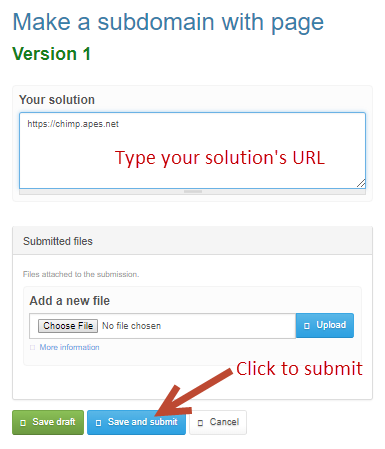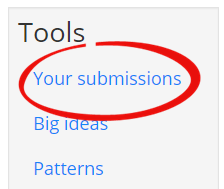There are two things on this Web site:
- Stuff to read
- Things to do
There's less to read than in a regular textbook, because it's the doing that makes the difference. However, you should read what content there is, since it explains how to do things.
Exercises
There are many exercises. They're part of the text. You'll find them as you read.

Don't skip them. When you find an exercise, stop reading, and do it.
What you read won't sink in unless you do the exercises. If you skip the exercises, you'll feel more and more confused. The concepts will seem more difficult than they really are.
Each part of the course builds on what came before. Exercises solidify what you read, so that what follows makes sense.
How to submit your work
For most exercises, you'll make web pages. You'll submit the URL of one or more of the pages.
How do you do that? Each exercise has a "Work on it" link at the bottom.

Click it, and a window will open, with a place to put your URL:

You can ignore the file uploading thing. That's for other courses.
You need to log in to your account to submit exercises. Ask you instructor for the deets on how to log in.
How do you get feedback? On the right of the screen is a Tools menu, with a link called Your submissions. (You'll only see it if you're logged in, of course.) Click Your submissions to get feedback on your work.

Your virtual class
Here are people taking the course with you:




There's also me, the person writing this. The others will ask me questions sometimes. Imagine an incredibly cool person. Then imagine someone who's not. I'm the second one.
Skimming
There's one more person to introduce.

This course is a bunch of lessons, one to a page. There's an exercise at the bottom of most lessons. Anderson likes to jump to the exercise first thing. He reads the exercise first, then skims the lesson, looking for bits that are relevant.

That sounds like a good idea, but it's not. Because Anderson hasn't read the lesson, he doesn't know what the exercise requires, and he doesn't know what to skim for. Sometimes he gets lucky, but often not. He'll spend more time figuring out why his code is broken, then he would have spent reading the lesson in the first place.
He'll also get frustrated.

No, it's not too hard. But it might seem that way to a skimmer.
Don't be like Anderson. Don't skim. Start at the top of each lesson, and read the whole thing.
A promise
There's no filler in the course. You know, detail you don't need to get the job done. Regular textbooks are full of that.
Not this course. Everything is aimed at the goal: making CRUD apps. Apps that businesses want.
There's only one type of extra, and they're optional. They're called…
CoolThings
CoolThings are for curious people who want to explore. Like putting a web server on your own computer, practical jokes, and other things. They're in boxes like this one. There's also a list of CoolThings from across the site.
OK, let's talk about what you'll learn.
